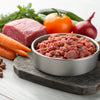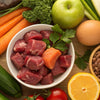Can I Give Raw Food to My Dog? Understanding the Pros and Cons of Raw Diets
- Houndsy
Table of Contents
- Introduction
- Understanding Raw Food Diets for Dogs
- Pros of Feeding Raw Food to Dogs
- Cons of Feeding Raw Food to Dogs
- How to Approach Raw Food Safely
- Balancing Raw and Cooked Diets
- Making the Best Decision for Your Dog
- Conclusion
Introduction
Have you ever wondered what your dog would choose to eat if given the chance? Would they opt for store-bought kibble or a fresh, juicy piece of raw meat? The debate around raw food diets for dogs has become a hot topic among pet owners, particularly as many of us seek to provide our furry companions with the best nutrition possible. In fact, a survey by the American Pet Products Association found that nearly 25% of dog owners in the U.S. are now incorporating raw food into their pets' diets. As the trend continues to rise, questions arise: Can I give raw food to my dog? Is it safe, and what are the potential health benefits or risks?
This blog post aims to navigate the complex world of raw food diets for dogs, exploring everything you need to know about what it includes, potential advantages and disadvantages, and the essential considerations to keep in mind. By the end of this article, we hope you will feel empowered to make an informed decision about your dog’s diet, and discover safer, more appealing alternatives to enhance their feeding experience.
What We’ll Cover
- The definition of raw food diets for dogs
- The potential benefits of feeding your dog raw food
- The risks and health concerns associated with raw diets
- Guidelines for safely incorporating raw food, if you choose to do so
- Practical considerations to keep in mind for your dog’s specific needs
Let’s embark on this journey to better understand whether raw food is a good option for your pooch!
Understanding Raw Food Diets for Dogs
What is a Raw Food Diet?
Raw food diets, often referred to as the BARF (Biologically Appropriate Raw Food or Bones And Raw Food) diet, focus on feeding dogs foods that resemble their ancestral diets in the wild. These diets typically consist of uncooked meat, organs, bones, and sometimes raw fruits and vegetables. Advocates allege that this approach mirrors what dogs would naturally consume and can lead to healthier, happier pets.
Key components of raw food diets may include:
- Raw Meats: Both muscle meats and organ meats from various animals.
- Bones: Raw bones that can provide essential nutrients and help maintain dental health.
- Fruits & Vegetables: Some diets incorporate uncooked fruits and veggies known to be safe and healthy for dogs.
The Origins of Raw Feeding
The concept of feeding raw food to dogs gained traction in the early 1990s when veterinarian Ian Billinghurst popularized the BARF diet. His arguments centered around the idea that dogs are biologically designed to consume raw meat rather than processed foods. Since then, interest in raw diets has burgeoned, with numerous commercial products now available in stores.
Pros of Feeding Raw Food to Dogs
Enhanced Nutritional Benefits
Proponents of raw food diets argue that these diets provide superior nutrition compared to traditional kibble. Here are some potential benefits:
- Better Digestion: Raw diets often contain high-quality, minimally processed ingredients that may be easier for dogs to digest.
- Shinier Coats: Owners frequently report that their dogs develop shinier, healthier coats when fed raw diets, likely due to higher levels of omega fatty acids found in certain raw meats.
- Improved Dental Health: Chewing raw bones can help naturally clean dogs' teeth and reduce plaque buildup, promoting overall dental health.
Weight Management and Energy Levels
Many dog owners have noticed positive changes in their pets’ weight and energy when transitioning to a raw food diet. The high protein content and absence of fillers in raw food can support weight loss or maintenance by allowing owners to control exactly what and how much their dog consumes.
Individualized Nutrition
A raw food diet affords pet owners the ability to tailor nutrition according to specific dietary needs or health issues. For instance, pet owners can opt for specialized proteins or add supplements to meet their dog’s unique requirements.
Cons of Feeding Raw Food to Dogs
Health Risks
Despite the potential benefits, raw food diets also carry significant risks that cannot be overlooked:
- Bacteria & Foodborne Illnesses: Raw meats can harbor dangerous pathogens like Salmonella and E. coli. These harmful bacteria can pose a health risk not only to the dog but also to the humans interacting with them. Research conducted by the CDC found that nearly a quarter of commercial raw dog food tested contained harmful bacteria that could cause illness.
- Nutritional Deficiencies: Without proper guidance, raw diets can quickly become unbalanced. Dogs require a specific ration of vitamins and minerals, and if they are not appropriately addressed in a raw diet, deficiencies can develop, potentially leading to serious health issues.
- Risk of Bone Choking or Obstruction: While raw bones can benefit dental health, they also pose a choking hazard or the risk of causing intestinal blockages if not selected and fed properly. Owners should always supervise their dogs when they are consuming raw bones.
Regulatory Concerns
Currently, there are limited regulations surrounding the production and sale of raw dog food, resulting in inconsistent standards for nutritional adequacy and pathogen testing. This inconsistency can increase the risk of feeding unsafe or unbalanced diets that might harm your dog.
How to Approach Raw Food Safely
If you are still curious about raw feeding and interested in introducing raw foods into your dog’s diet, here are some essential safety tips to consider:
Research Thoroughly
Before making any dietary changes, it’s crucial to conduct thorough research. Consult reputable sources—this includes speaking to your veterinarian, who can provide guidance tailored to your dog’s specific health needs.
Choose Commercially Prepared Raw Diets
If you opt to feed raw food, consider commercially prepared diets that meet the standards of the Association of American Feed Control Officials (AAFCO). Such products should be formulated by veterinary nutritionists and have undergone rigorous safety testing.
Incorporate Safe Handling Practices
If you’re preparing raw food at home, always prioritize safety:
- Thoroughly wash your hands before and after handling raw ingredients.
- Use separate cutting boards and utensils for raw meats and human food.
- Clean any surfaces that come into contact with raw food promptly and thoroughly.
Supervise Feeding
Always supervise your dog when introducing new foods, especially raw bones or meats. Take time to observe how they respond, as this can help you identify any adverse reactions.
Balancing Raw and Cooked Diets
Many pet parents have found it useful to combine raw and cooked food options to create a balanced diet. Cooked meats, vegetables, and grains can be excellent sources of nutrition while mitigating some of the risks associated with raw feeding.
Consider cooking meats thoroughly and adding healthy fruits, vegetables, and grains to enhance their overall diet. For instance, boiled chicken can be a protein-rich addition to commercial kibble, creating a delightful mixed meal for your furry friend!
Making the Best Decision for Your Dog
Ultimately, the choice to feed your dog raw food should be made carefully. Every dog is unique, with different health needs, preferences, and reactions to diet changes. It’s critical to evaluate your dog’s health status, age, activity level, and any underlying health conditions before deciding to switch their diet.
Reflective Questions:
- Have you noticed any sensitivities or preferences in your dog’s current feeding routine?
- What values do you prioritize when it comes to your pet’s health and nutrition?
Conclusion
As we’ve explored the topic of feeding raw food to dogs, it’s clear that this approach comes with both potential benefits and significant risks. While many pet parents advocate for raw diets, it’s essential to make informed, research-backed decisions tailored to your dog’s health and well-being. Consulting with your veterinarian and exploring safer feeding methods—such as enhancing traditional kibble with fresh, cooked ingredients—may be the more prudent route.
We invite you to elevate your pet’s feeding experience further with the Houndsy Kibble Dispenser, designed to provide convenient, perfect portions every time. With its stunning mid-century modern design, it complements any home decor while enriching your dog's feeding routine. Explore it today to learn how simplicity can enhance your dog’s mealtime delight! Order Now.
FAQ
Q: Is a raw food diet safe for all dogs? A: Not necessarily. Raw diets can pose risks, particularly for puppies, senior dogs, and those with compromised immune systems. Always consult your veterinarian before making changes.
Q: What are some benefits of feeding raw food? A: Potential benefits include better digestion, improved coat health, and enhanced dental hygiene. However, these can vary significantly from dog to dog.
Q: Are there risks associated with raw diets? A: Yes, raw diets carry risks such as bacterial infections, nutritional deficiencies, and choking hazards from bones.
Q: Can I mix raw and cooked foods? A: Many pet owners find success by combining raw and cooked foods, allowing for a balanced diet while minimizing risks.
Q: How can I ensure my dog’s diet is balanced? A: Consult a veterinarian or a pet nutritionist to develop a meal plan that provides all necessary nutrients while considering your dog’s specific needs.













